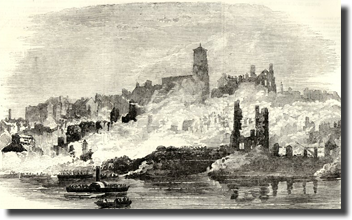In the year 1138 Newcastle was occupied by King David I of
Scotland (Feast Day May 24th) it did not return to the Kingdom of England until
1157. The New Castle on the ruins of the Roman fortress of Pons Aelius had been
built in 1080 by Robert II of Normandy eldest son of William the Conqueror and
hero of the First Crusade. David’s family already had associations with
Newcastle because his Grandmother and Aunt fled there after the death of
Malcolm III and St Margaret in 1093. Malcolm III was killed at Alnwick with his
eldest son on the way back from a campaign in Northumbria during which he had
attended the foundation of the new Cathedral Church at Durham. Hearshaw
continues…
“Queen Margaret of Scotland (sister of Edgar Atheling) survived this
double loss only four days, and Scotland became the prey of civil war and
anarchy. In these circumstances Margaret’s aged mother, Agatha, and her sister
Christina, fled to England, their native land, sought shelter in Newcastle, and
there ‘were espoused to Christ’ in the newly founded Nunnery of St Bartholomew,
first of Newcastle’s religious houses.”
This Nunnery was destroyed at the
Reformation. The indoor Grainger Market and Nun Street mark the land where it
once stood. Now Hearshaw is certainly wrong about England being “their native
land” as neither of them can have been born there. In fact the place of
Agatha’s birth and how she fits into the great extended family of saints
surrounding St Stephen of Hungary and St Henry the Emperor is a great
historical mystery. Agatha lived out her remaining years as a nun in Newcastle
but her daughter did not stay in Newcastle. Christina went on to be the Abbess
of Romsey where she educated Malcolm and Margaret’s daughter Edith (later
renamed Matilda) by whose marriage to Henry I the royal line of Wessex was
united to that of Normandy. This union was later threatened by the survival of
only one child of Henry I, his daughter Matilda. Although the Barons agreed to
accept her as heir before Henry I’s death, when the King actually died most
rallied to her cousin Stephen (famous coward of the First Crusade) sparking a
protracted civil war. This helped to provide a pretext for expansion southward
by David I (son of Malcolm III and uncle of Matilda)…
“In 1137 a muster of
local troops at Newcastle prevented David from pressing his attack far to the
south. In 1138, however, his host reached Northallerton in Yorkshire; but there
it met with a heavy defeat at the hands of the militia of Yorkshire in the
famous ‘Battle of the Standard.’ Nevertheless, though this English victory
saved Yorkshire from Scottish occupation, it did nothing to relieve
Northumberland, nearly all of whose castles were by this time in David’s
possession. The hopeless Stephen, distracted by civil war and debilitated by
baronial treachery, felt constrained to make peace on his adversary’s terms.
Hence by the Treaty of Durham (1139), the much coveted Earldom of
Northumberland was revived and conferred upon Henry, David’s eldest son and
heir. Newcastle was not included in this grant. In spite of that fact, however,
the Scots took possession of it and held it for some eighteen years.
The
Scottish occupation was a notable episode in the history of the town. It was
quite clear that David regarded Northumberland as permanently incorporated into
his kingdom, and many things indicate that Newcastle was soon in fair way to
supersede Edinburgh as his capital and seat of government. He himself was much
in the town; he showed it peculiar favour; he issued his laws therefrom; he
adopted its customs as models for the four Scottish boroughs of Edinburgh,
Stirling, Roxburgh and Berwick (hence the inclusion of the customs of Newcastle
in the Scottish Statute Books); he caused, it is supposed, the old English
church near the White Cross to be refounded and rededicated to the Scottish St
Andrew; he refounded the nunnery of which his grandmother and his aunt had been
inmates. From Newcastle he extended his wide authority over Northern England.
Before the end of 1141 (when the cause of Stephen appeared to be ruined and
that of Matilda triumphant) he had secured Carlisle, and had made himself
master of Cumberland, Westmorland, and a large part of Lancashire. A dependent
of his moreover acquired the palatine bishopric of Durham, and the largest
dreams of Scottish expansion seemed likely to be realised.
Three deaths,
however, those of Henry, Earl of Northumberland, in 1152; of David
himself in 1153; and of Stephen in 1154 – completely changed the political
situation, and prepared the way for the English recovery of Newcastle and
North.”
Of course, the Scottish Kings
were rather more English than the Kings of England at this time as they
represented the elder branch of the house of Wessex. Hearshaw is probably wrong
about St Andrew’s as well. It is likely that it was always dedicated to the
Apostle on account of the devotion to him in the region stemming from St
Wilfred’s translation of relics of Andrew from Rome to Hexham in the seventh
century. In fact, I am reliably informed, it is quite likely that the relics of
St Andrew in Fife and the consequent dedication to Scotland to him probably
stems from the theft of some or all of these relics in one of the many raids of
the period or their transportation to Fife by a disgruntled deposed Abbott of
Hexham. In fact, it was not until after the period discussed here that the term
Scotia was used to include the region bellow the Firths of Clyde and Forth. The
eastern part of this region still being seen as Northumbrian, giving rise to
the surprising fact that St Cuthbert is the patron of Edinburgh and St Andrew
of Newcastle.















